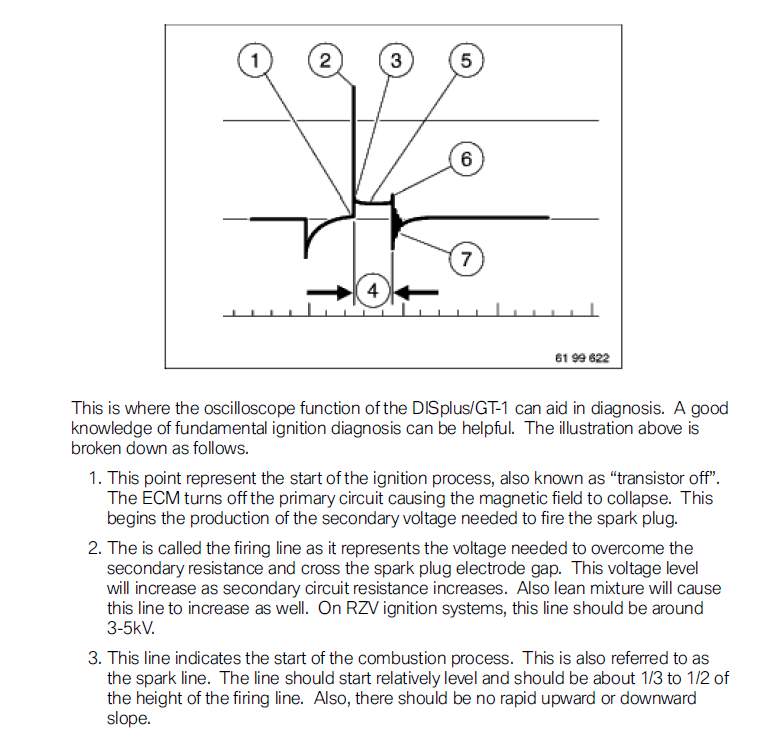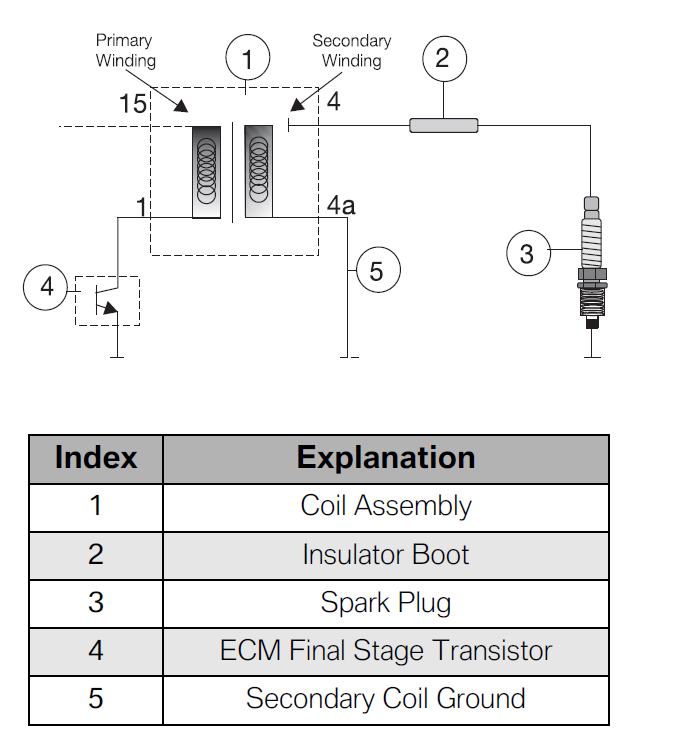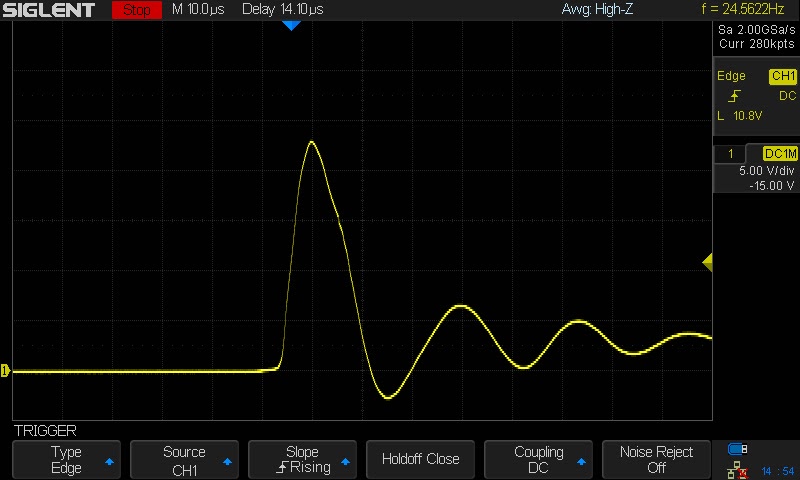In the century, when humans are planning to go to Mars, it doesn’t seem logical, that BMW was not capable to create a stable and safe engine ignition system. While using my test stand for ignition coils, I noticed strange nuances in the coil’s performance and decided to research this situation in a real engine.
Below you will find a technical descriptions for specialists. If it’s not for you – go directly to “Solution”.
I took my oscilloscope and started to check, what’s happening on the primary coil of the ignition coil.
In technical documentation “Ignition strategy” and “BMW engine diagnosis”, BMW points out, that in Homogeneous mixture mode arc is kept on 2 .. 3 kV, initial spike 2 .. 3 times above this level.

In truth, even in BMW document the “firing line” is much brisk than their own declaration regarding 2 .. 3 times above (3) level.
So I start to measure.
The connection diagram is classical, nothing interesting here:

First image already reveals some oddities.
Frequency range: 100 MHz; Sample rate: 2 Gs

Vertical scale 1 : 10, it means, one section is 100 V.
Measurement performed in idle run, Homogeneous mixture mode.
As you can see, in time of arc the voltage in primary side is 30 .. 40 V, which corresponds to 3 .. 4 kV in secondary side (thanks to transformation coefficient 1 : 100) – approximate conformity to values mentioned in BMW documentation, if we keep in mind, that spark plugs used in N53 engine has wider air gap than for “regular” engine.
But short impulses in primary side reaches 380 V, which corresponds to ~38 kV – some 10 (!) times above confirmed value of arc voltage. Of course, this engine has situations, when higher voltage for keeping the arc will be necessary, for example: Homogeneous lean mode, when Lambda in all combustion chambers is approximately 1,5. But 10 times – it’s too much even for N53…
The fact, that such high voltage is possible at all, is very interesting by itself – all requirements for the arc is already by much lower voltage!
Zoom in the picture to see more details:

This is the beginning of the ignition process in all its beauty. Not even close to one described in literature! So – what is going on here?
MSD80/81 uses “intelligent” IGBT ignition switch ISLV9V5036, produced by Fairchild. Producer’s datasheet here:
ISL9V5036
Checking the datasheet, I already see some interesting nuances:
a) clamp connection of over-voltage protection is connected between transistors collector and gate (not collector and emitter), which can be the cause of generation in certain circumstances;
b) max value of current fall time (Tfall) for transistor: 15 us, but typically it’s ~2,8 us, which is 5 times less.
Accordingly, the distribution of this parameter is very wide – also the performance of the whole module can differ, depending on a particular sample of the switch (also from temperature or other conditions: a primary current/power supply voltage, etc.).
So what is happening in the picture?
When IGBT’s Ic reached approximately 6 .. 9 A, ISLV5036 from MCU receives low-level signal (command) to close. After a time-lapse of Toff time (and reaching the Miller’s threshold on the gate), the transistor starts to close.
Typical current fall time (Tfall) is quite low and voltage Uc reaches 350 .. 380 V threshold within few us, which corresponds to transistors over-voltage protection level. Within this fast-growing voltage period gate current didn’t discharge gate capacitance significantly lower than Miller’s threshold (mostly thanks to high gate resistors value, typically 100 Ohm .. 1 kOhm) and over-voltage protection reacts almost immediately – transistor is forced to turn on repeatedly. Thanks to gate capacitance and transistors (also – clamping circuit) limited reaction time, voltage Uc drops down almost till 0.
At this moment voltage at gate drops down (gate capacitance is discharged through the gate resistor), the transistor turns off and Uc rises up and – oscillation process is initiated.
The optimistic scenario says, that the next two pikes are parasitic resonance oscillations and transistor (finally) has closed correctly (and totally). I’m not such an optimistic person, so I think, that also these pikes are with a transistor in active mode (clamp chain has not been able to be disconnected properly).
After 10 us finally, the spark period starts – the voltage in the secondary side drops rapidly, but the process of slowly decreasing oscillations continues.
In the first moment looks like – this is the picture of primary side: unconnected inductance, but no… Test “on the table” shows, that in a scenario with rapid closing of transistor two types of spark are observed: first of them is with higher “voltage”, but thin and with less energy, second – strong, but breaks through a smaller air gap. Slowing down the transistor’s closing time (but not changing the maximum Uc), only the second: stronger spark stays. It means, that this breakthrough of several us is monitored also in the coil secondary side.
Seems the air ionization time is more than 2 .. 3 us, if high voltage pulse rise time is lower than this value – required voltage to start ignition rises significantly.
What are the consequences of such a transition process?
1. Very (unlimited) high voltage in the secondary side for first few us: such voltage damages ignition coil’s tufts, launches spark discharge outside the spark plug and can cause damages inside the ignition coil;
2. Increased heating of output IGTB/MOSFET transistors – for first 10 us they are performing in the active mode, turning part of the energy (stored in ignition coil) into heat;
3. The energy, intended for spark period, is decreased, and in such important stage of formation potential in the second side is not stable and high (but many times drops down much lower than optimal).
Why such situation has occurred?
Since a long time ago, the control of ignition coils is made very simple: transistor (switch) and coil. That’s it, nothing special. MSV70, MSV80, MSD80 – output cascades are identical for all of them. But – ignition coils itself has changed significantly: MSD80 uses coils with higher inductance, larger transformation coefficient and also much more accumulated energy. If with coils of previous generations (“ordinary” coils) problems described above were not so significant and didn’t cause much harm, with ignition coils, used in N53, the situation actually is a catastrophe.
IRFW644B
If these transistors are used, the situation is even worse. Max voltage Uds is limited by 250V! Moreover, these MOSFETs don’t have any overvoltage protection inside the crystal!
What to do in this situation?
For test reasons, I created a simple snubber circuit, which consists of 0.15 uF film capacitor and 10 R, 4 W resistor, connected in series. I connected this circuit parallel to the primary winding of the ignition coil. See the oscillogram after attaching the snubber:

The Y-axis scale in this picture is 50 V/section.
As we see, the oscillation process is gone, the first spike has gone down for ~2 times, first 8 .. 10 us the Plato is nice and even, after 10 us it passes to stable spark period.
With a modified test cylinder (one) I drove for several motor hours in different engine performance modes to be sure, that there is no misfire, that the snubber resistor can handle short-time overloads (above 500 W for several us in each cycle).
After optimizing the components, I chose 0.1 uF 305 VAC foil capacitor and 3 pcs 22 R, 2 W resistors, connected in parallel (to increase the ability of peak power).
Using this configuration, the first spike increased in first few us till 230 .. 240 V, but the thermal load to snubber resistors has decreased.
Of course, also dU/dt after the closing of the transistor has decreased. Before attaching the snubbers, it was 200 .. 300 V/us, after: 50 V/us.
Also, IGBT is relieved during the phase of a turn-off. Dynamic losses are significantly decreased because the Ic of the transistor falls more quickly than I (current) via snubber. Now IGBT works in soft-switching mode, comparing to hard switching mode before.
Final edition picture in real time:

First spike is about 230 V, almost immediately the break is visible – at this moment the spark period starts to form. After forming, the process of oscillation process is imperceptible and quickly drops down. The problem with repeated opening of transistor, work in active mode, power losses and too high Uc voltage in first few us is completely eliminated.
Solution.
Simple description in Wikipedia: RC snubbers
Components:
a) resistors: with high pulse power (regular overload ability above 300 .. 500 W with pulse length 1 us), 2 .. 3 W rated power dissipation, metal film (not wirewound!!!). For example, Vishay PR02 series;
b) capacitors: with low dissipation factor (0,1 % by 1 kHz or less), high impulse current, dielectric: polypropylene or polyester.
Costs of components: about EUR 5 for 6 cylinder engines.
In the picture: above: 22 R, 2 W resistors, below – capacitors: 0.1 uF, 305 VAC.

All components placed in thermal insulation tubes:

So looks the installation. Snubbers placed in niche between ignition coils, wires – placed together with stock wiring.
Connection diagram.
Pin1 and Pin3: marked with red.





